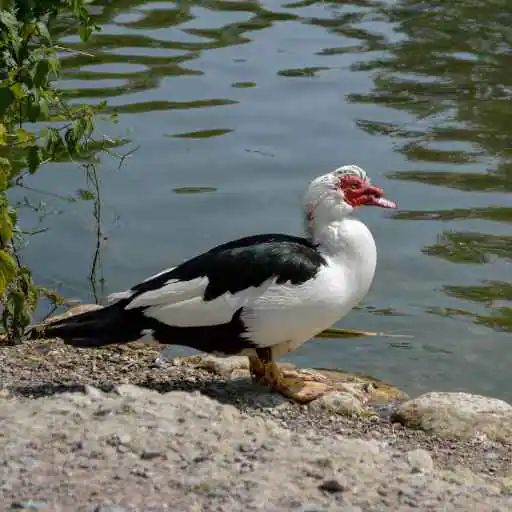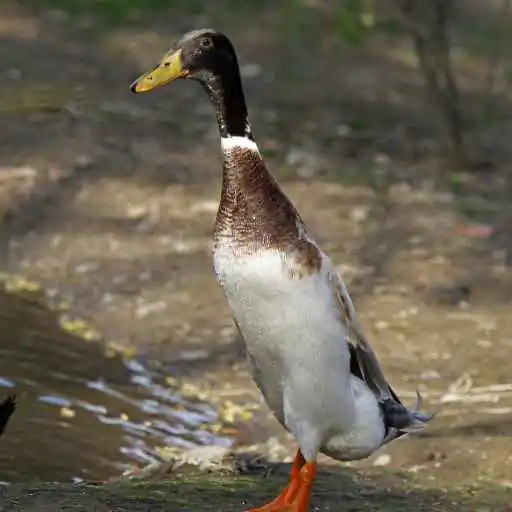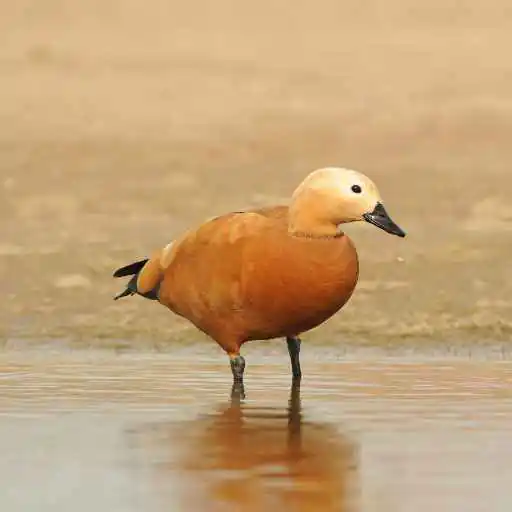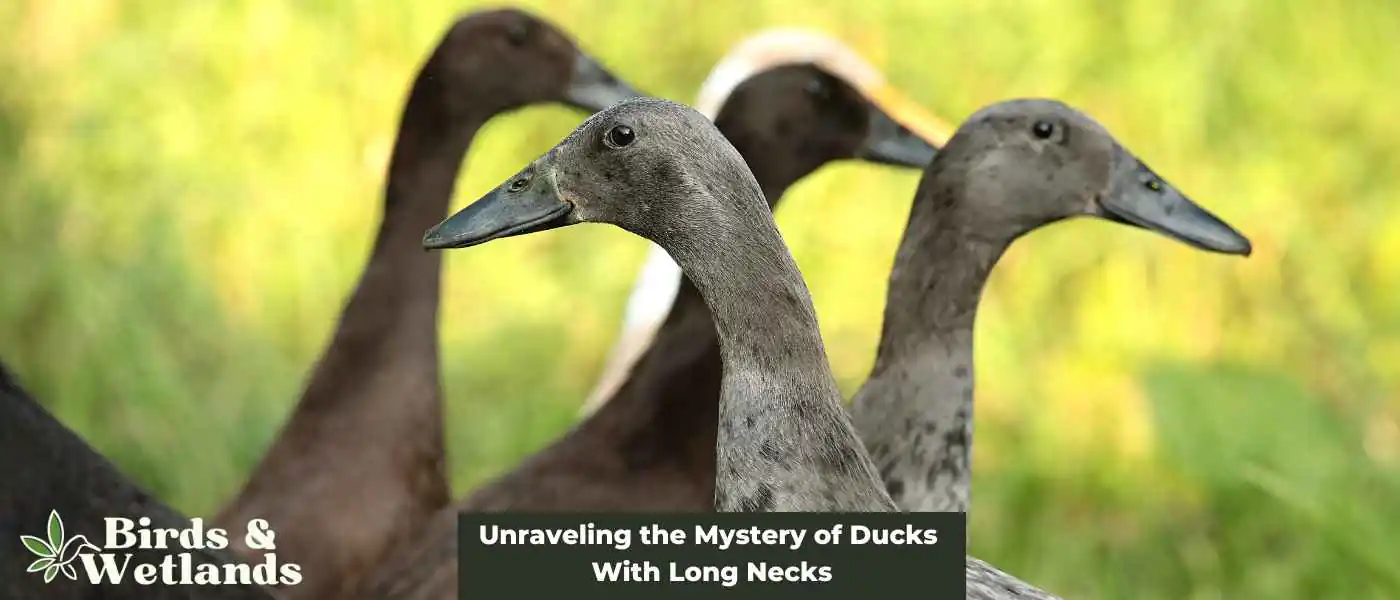Ducks are some of the most delightful creatures on the planet, and ducks with long necks are no exception. With their graceful, elegant, and majestic beauty, they will surely capture the hearts and imaginations of young and old alike.
In this blog post, we will look at some of the most popular ducks with long necks and their unique characteristics. So without further ado, let’s dive right in and explore the wonderful world of ducks with long necks!
Muscovy Ducks
Muscovy Ducks

The Muscovy duck is one of the most common domestic breed of ducks.
- Wild Muscovy ducks inhabit wetland habitats, including lakes and ponds.
- It is known for its loud honking sounds.
- It primarily eats aquatic vegetation.
The Muscovy duck is a large and beautiful duck native to South and Central America. It has stunning black, white, and red feathers, plus bright red facial protuberances only found on the male Muscovy.
Though not as beautiful as the Mandarin duck, the Muscovy duck is still a pretty duck with their white and dark plumage. The black feathers have a greenish gloss finish.
The male Muscovy is about 27 inches long and can weigh up to 8 pounds, while the female Muscovy is smaller, measuring up to 24 inches and weighing up to 4 pounds.
These ducks make their homes in lakes, ponds, parks, and farmland, and they love to eat plant material, insects, and snails.
They are famous for their loud honking sound and their fast flying ability.
Domestic Muscovy ducks are popular on small farms and homesteads because they are hardy and easy to care for. They are also great for getting eggs and meat, and their droppings are a great natural fertilizer for gardens and lawns.
Wild Muscovy ducks sometimes lay eggs in tree holes and nests of other ducks.
It’s important to note that wild Muscovy ducks are considered invasive in some parts of the world.
Indian Runner Duck
Indian Runner Duck

The Indian Runner Duck is a breed of domestic duck native to Southeast Asia.
- They have an upright posture like penguins and a variety of feather colors.
- They are excellent egg layers, foragers, and pets.
- They can adapt to a range of climates.
The Indian runner duck is a breed of domestic duck known for its upright posture and distinctive appearance. They are medium-sized ducks that are native to Southeast Asia and were brought to Europe and other parts of the world for their egg-laying abilities.
These domestic ducks are also excellent foragers on land and will catch small animals for food, making them ideal for free-range duck keeping. These ducks are also popular pets due to their playful and social personalities.
These ducks have a narrow, streamlined body shape, a long neck, and an upright posture, which distinguishes them from other duck breeds. They have a variety of feather colors, including white, black, blue, fawn and chocolate.
Indian runner ducks are hardy birds that can adapt to various climates and conditions.
Black-bellied Whistling Duck
Black-bellied Whistling Duck

The black-bellied whistling ducks are species of ducks native to the Americas.
- Distinctive long neck, round head and large bill
- Highly social, feed on aquatic vegetation, insects, and crustaceans
- Common and found from US to South America
This duck is found in the Americas. It’s named for its black belly and whistle-like call. These ducks have a reddish-brown head and neck for the males and brownish-gray for the females.
They are often seen in groups and feed on aquatic vegetation, insects, and small crustaceans near the water’s surface. They are strong fliers and good swimmers and divers.
Black-bellied whistling ducks range from the southern U.S. to South America and are not considered threatened. They play an important role in controlling insect and plant populations in the ecosystem.
White-faced Whistling Duck
White-faced Whistling Duck

White-faced Whistling Ducks are found in sub-Saharan Africa and South America.
- They are known for their distinctive white face and high-pitched whistling calls.
- They are highly social and can often be found in large flocks near water sources.
- They feed mainly on seeds and plant material, but habitat loss and hunting can still present a threat to their populations.
The White-faced Whistling Duck (Dendrocygna viduata) is a duck found in sub-Saharan Africa and South America. They are known for their distinctive white face and high-pitched whistling calls, which are heard at night and early morning.
These ducks have medium-sized bodies and long necks, with brownish-grey plumage and a distinctive white patch on their cheeks. White-faced
Whistling Ducks are highly social and usually form large flocks near water sources, such as lakes, rivers, and marshes. They feed mainly on seeds and plant material and are known to be strong fliers that can travel long distances in search of food.
While populations of white-faced whistling ducks are stable, habitat loss and hunting for meat and eggs can still threaten their populations in some areas.
Indian Spot-billed Duck
Indian Spot-billed Duck

The Indian spot-billed duck is a species of dabbling duck found in South Asia, Southeast Asia, and East Asia.
- Medium-sized with a distinctive bill and yellow tip
- Feed on plants, seeds, and insects
- Common bird but populations may be declining due to habitat loss and hunting
It is a medium-sized duck measuring about 48 cm in length with a wingspan of about 72 cm.
The males have a green head and neck, a brownish-grey body, and a white patch near the tail. The females are brown with dark crowns and lighter underparts. Both sexes have a distinctive, triangular-shaped bill with a yellow tip and black spots.
These Indian spot-billed ducks feed on plants, seeds, and insects, and they are known to dive and upend to forage in deeper water.
They are non-migratory birds, typically found in wetlands, including freshwater lakes, ponds, rivers, and rice paddies.
Northern Pintail
Northern Pintail

The northern pintail is a migratory duck species that breeds in the northern hemisphere.
- Males have brown head, a white stripe and gray back, females are mottled brown.
- Found in coastal areas and freshwater marshes in winter.
- Long-distance migrators, abundant and widespread.
It is a migratory duck species that breed in North America, Asia, and Europe. Their distinctive long, slender, pointed tail gives them their name.
Males have a brown head, a white neck, and a gray back, and white patch on the wings. Females are mottled brown with a white belly.
In the winter, this long-tailed duck can be found in coastal areas and freshwater marshes along North America’s Pacific, Atlantic, and Gulf coasts with other birds. Some flocks also exist in Canada. They eat seeds, invertebrates, and other aquatic plants. Unlike true diving ducks, northern pintails can only submerge their heads underwater for a few seconds.
Northern pintails are also known for their long-distance migrations, traveling thousands of miles yearly between their breeding and wintering grounds.
Fulvous Whistling Duck
Fulvous Whistling Duck

Fulvous whistling ducks are a species of waterbird native to much of the Americas.
- They are known for their rusty-brown plumage, white stripes, blue-gray webbed feet, beaks and legs, and whistling call.
- They eat seeds, invertebrates, and aquatic plants, and can benefit ecosystems.
- They are currently of “Least Concern”, but habitat loss is a concern.
The fulvous whistling duck (Dendrocygna bicolor) is a waterbird species native to much of the Americas, including much of the Caribbean, Central America, South America, and parts of the southern United States such as Florida. It belongs to the Anatidae family.
These birds are known for their distinctive appearance, long necks, rusty-brown plumage, and whistling call. They are also known for their highly social behavior, often seen swimming in flocks of hundreds of birds in wetland habitats.
Fulvous whistling ducks eat various food sources, including seeds, invertebrates, and small aquatic plants, which they find by diving into the water. These dabbling ducks are also known to eat crops, leading to conflicts with farmers.
Despite this, these birds are generally considered beneficial to ecosystems due to their role as seed dispersers and their ability to control insect populations.
Ruddy Shelduck
Ruddy Shelduck

The ruddy shelduck is a large and social waterfowl species that is threatened in some areas due to habitat loss and degradation.
- Ducks that are native to Eurasia.
- It is a large, social bird with a wingspan of up to 110 cm.
- These ducks eat plant material.
The Ruddy Shelduck (Tadorna ferruginea) is native to Eurasia and is also known as the “Indian Shelduck.” It is not the same as the ruddy duck.
The ruddy shelduck is a large duck, measuring about 50-60 cm in length, with a wingspan of up to 110 cm. The males have a distinctive ruddy-brown plumage and a dark green head, while the females are lighter in color with a more brownish-grey plumage.
These ducks eat grass and small aquatic creatures, including small fish, mollusks, crustaceans and invertebrates.
The ruddy shelduck is a highly social bird, often seen in large flocks in breeding and non-breeding seasons. During the breeding season, they build nests on the ground near water sources, and the female lays an average of 8-12 eggs. The female takes care of the ducklings.
The Ruddy Shelduck is a migratory bird, with some populations wintering in South Asia and others in Africa. The species has a stable population, but it is considered a threatened species in some areas due to habitat loss and degradation.
Conservation efforts, including habitat protection and management, are necessary to ensure the survival of this unique and beautiful species.
Key Takeaways on Long-Necked Duck
- Muscovy ducks are among the most common domesticated ducks.
- Ducks with long necks are often mistaken for small geese.
- You can easily identify ducks on this list with their long necks.

